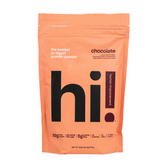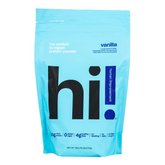The Big Takeaways:
You’re not getting enough fiber in your diet.
+ Over 90% of adults don’t get nearly enough fiber. To help boost your fiber intake load up on fruits, veggies, whole grains, nuts, seeds, legumes, and beans. You can also add fiber to your diet through supplements and protein shakes.
Fiber is a non-digestible carbohydrate.
+ Even though you can’t digest fiber, it still plays a crucial role in your energy by regulating your blood sugar levels and moving things along in your digestive system.
There’s more to fiber than keeping you regular.
+ Fiber helps lower your cholesterol and glucose levels, promotes better digestion, improves your gut health, and keeps you feeling full for longer.
Meet fiber, the food that’s been popularized for “keeping you regular”. At least, that’s its claim to fame.
There’s actually much more to fiber than just regular digestion. Fiber is also essential for boosting your immunity, managing your weight, supporting your heart health, among many other benefits.
Since fiber has the ability to impact so much of our body’s health, it’s startling to see that only 10% of American women and 3% of American men get their recommended daily dose of fiber. That means over 90% of us — especially the men out there — aren’t getting nearly enough fiber in our diets.1 2
If you only take one thing away from this blog, it should be that adding more fiber to your diet is not optional but essential to your health. We’ve digested (pun intended) the latest science and studies to help you understand why fiber is important, the risks of not getting enough, and why it’s a must in your protein.
What is fiber?
There are three different kinds of carbohydrates: fiber, starches, and sugars.3 All three are necessary for giving your body the energy it needs to function — but they each play a different role in that goal.
Of the three, fiber is the only one your body cannot digest. But this doesn’t make its role any less crucial.
As fiber passes through your body it helps regulate your blood sugar levels and move things along in your digestive system.4 So although starches and sugars break down to glucose, your body’s preferred source of energy, it’s the fiber that helps regulate and distribute all that energy throughout your body.4
Improvement Tip: High fiber foods include whole food protein powder, fruits, veggies, legumes, beans, whole grains, nuts, and seeds. You can also add fiber to your diet through supplements like Human Improvement Protein Powders.Soluble vs. insoluble fiber
There are two different types of fiber that your body needs: soluble and insoluble. The difference comes down to whether that fiber can or cannot dissolve in water.
Soluble fiber dissolves in water and helps keep your glucose and cholesterol levels low by absorbing cholesterol and acids in the gut and slowing down your digestion in the process.4 5 6 This helps maintain a healthy gut and keeps you feeling full for longer.6
Soluble fiber foods include:
- Lentils
- Oats
- Peas (like the pea protein found in Human Improvement Protein Powder)
- Carrots
- Barley
- Fruits like apples and blueberries
- Psyllium Husk Powder (found in Human Improvement Protein Powder)
- Dark chocolate (found in Human Improvement Chocolate Protein Powder)
Insoluble fiber doesn’t dissolve in water. Because of this, it helps physically move nutrients (and toxins your body wants to get rid of!) through the body. This supports a healthy digestive system while flushing out the bad stuff your body no longer needs.4
Insoluble fiber foods include:
- Seeds (like the flaxseeds and pumpkin protein in Human Improvement Protein Powder)
- Nuts
- Whole grains
- Whole wheat flour
- Brown rice (like the brown rice protein in Human Improvement Protein Powder)
- Some veggies like zucchini and cucumbers
- Crickets (you can find insoluble chitin in our Human Improvement cricket protein powder)
- Cocoa powder (found in Human Improvement Protein Powder)
- Coconut milk (found in Human Improvement Protein Powder)
Improvement Tip: A well-balanced diet includes a healthy mix of both soluble and insoluble fibers, like what you’ll find in our Human Improvement Protein Powders.What is a prebiotic?
Prebiotics are a type of fiber that acts as food for the healthy bacteria in your gut.7 While all prebiotics are fiber, not all fiber is a prebiotic.6 You can find these special bacteria-feeding fibers in foods like fruits, vegetables, and whole grains.
Feeding your good gut bacteria, called your microbiome, improves your energy levels, mood, digestion, immunity, and overall health.6 8 One study on mice found that an unhealthy gut microbiome could even impact your weight.6
Improvement Tip: You can find prebiotic fibers in Human Improvement Protein Powder ingredients including psyllium husk powder, cricket protein powder, flaxseeds, and cocoa powderHealth benefits of fiber
Those insoluble, soluble, and prebiotic fibers are hard at work aiding in your body’s digestion, regulating your blood sugar levels, and keeping you feeling full for longer.3
Without enough fiber in the diet, you’re likely to feel exhausted, constipated, and/or bloated. You’re also more likely to struggle with weight gain and blood sugar fluctuations.9 For these reasons and more, it’s important to keep your body fueled with plenty of healthy fiber.
Here is a research-backed list of some of fiber’s biggest health benefits:
- Lowers cholesterol and glucose levels: Thanks to fiber, you can reduce your risk of inflammation, heart disease, stroke, hypertension, cardiovascular disease, type 2 diabetes, obesity, among other health concerns1 4 5 6 8
- Promotes better digestion: Healthy digestion keeps everything running smoothly in the body (and prevents unpleasant experiences like constipation or bloating)
- Improves your gut health: Fiber helps keep the good little gut bacteria happy and thriving, which improves your immunity and boosts your energy6 8
- Keeps you feeling full: Fiber helps regulate food intake and promotes a healthier diet by increasing feelings of fullness6
Why does fiber help you feel full?
To explain why, let's think about fiber like a lift line at a ski resort. One lift chair at a time carries boarders and skiers up the mountain who are then able to enjoy skiing down the mountain one group at a time.
But if all those skiers come blazing down the trail at the same moment with zero regulation that’s a bit overwhelming. By distributing the number of skiers on the mountain you avoid absolute chaos.
In the food world, this chaos is called a sugar rush. Fiber helps regulate your body’s intake of sugar, aka your body’s fuel, just like a ski lift regulates the number of skiers on the mountain. This is why two types of food with similar amounts of sugar, like an apple and a cookie, have such different effects on the body.
The apple (high in fiber) distributes its sugar over time while the cookie (low in fiber) delivers its sugar all at once. This is a big reason why after eating a cookie you only feel full for 5 seconds before you’re ready for more, even if that cookie contains more calories than the apple.
And when you pair a high amount of fiber with a high amount of protein your satiation (or fullness) possibilities are endless. In other words, you’re going to feel a happy and satisfied feeling of fullness because you just ate something super healthy.
Improvement Tip: A high-fiber and protein diet keeps you feeling full (of good, high-quality food) throughout the day which helps prevent you from eating extra calories from low-quality processed food. Try replacing “snacks” like chips and candy with a high-fiber protein smoothie instead.
.
How much fiber do I need?
Every(body) is different, however, the United States Department of Agriculture (USDA) recommends 22-28g of fiber per day for women and 28-34g of fiber per day for men.2 As it stands, most Americans only get half of that, or around 15 grams.3 6
The easiest way to start is by adding more fruits, veggies, and whole grains to your diet. Then, supplement with a high-fiber protein smoothie like Human Improvement to ensure you meet your recommended daily dose. Or better yet, combine the two with one of our Museum of Smoothie recipes.
What happens if I don’t get enough fiber?
The low levels of fiber in the average American diet are enough for the USDA to raise the alarm and call this a major public health concern.2 That’s because low levels of fiber can cause constipation, weight gain, fatigue, low blood sugar, and increase your risk for heart disease, diabetes, irritable bowel syndrome, colon cancer, and more.8 10
Improvement Tip: Get into the habit of looking at the back label of food products while grocery shopping. When looking at a food label, anything less than 3g of fiber or 5% daily value (DV) is too low in fiber.1 11 The more aware you are of the amount of fiber in the foods you’re eating, the easier it will be to meet your daily fiber needs.
Look for high fiber in your protein powder
Fiber (or the lack of fiber) is currently one of the largest health concerns in the nation. Our mission at Human Improvement is to help improve the health of our bodies and our planet.
So, to make a small solution to this larger problem, we created our Human Improvement Protein Powder that has 4-5g of dietary fiber from real whole food and sustainable ingredients including:
- Organic protein powder blend (cricket, pumpkin, brown rice, pea)
- Psyllium husk powder
- Dairy-free coconut milk
- Cocoa powder
- Natural dark chocolate
- Organic flaxseed
This is over 14% of your daily value of fiber in just one delicious serving of protein powder. And while other protein powders cause bloating, this gut-supporting blend is loaded with soluble, insoluble, and prebiotic fibers that support a healthy gut microbiome. Add one packet of our protein powder to your morning routine to increase your fiber intake.
Benefits of fiber
Megan Clark






